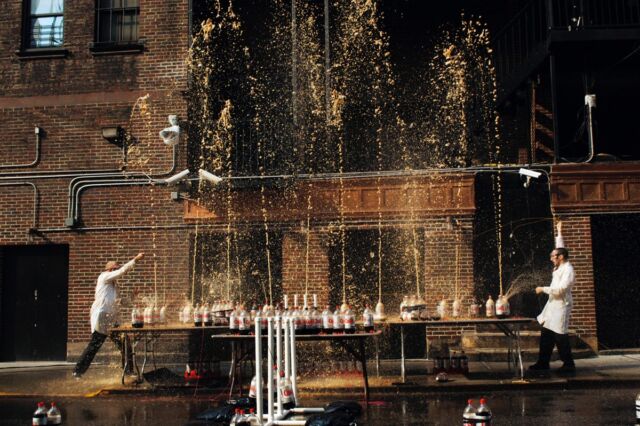Back in 2006, Fritz Grobe and Stephen Voltz—the self described mad scientists behind Eepybird—ignited an Internet sensation with their viral video of an elaborate version of the Diet Coke and Mentos fountain experiment, recreating the choreography of the Bellagio's world-famous fountain display in Las Vegas. The underlying physics and chemistry of the fountain effect is well-known.
But an intrepid pair of scientists at Spring Arbor University in Michigan wondered whether altitude, and associated changes in atmospheric pressure, would have any measurable impact on the intensity of the foaming fountain, and performed a series of experiments to find out. They reported their results in a recent paper in the Journal of Chemical Education. The upshot: If you really want to get the most foaming action for your buck, conduct the Diet Coke and Mentos experiment at high altitudes.
Grobe and Voltz didn't invent the basic demo. That's been around since at least the 1980s, although originally creative science teachers used Wint-O-Green Lifesavers threaded onto a pipe cleaner to induce the fountains of foam in soda bottles. In 1990, the size of the Lifesavers changed, and were too big to fit into the bottle mouths. So science teachers switched to Mint Mentos candy to achieve the same effect.
More physics than chemistry
The effect is commonly misunderstood to be a chemical reaction, on par with mixing baking soda with vinegar, but the underlying mechanism is actually a physical reaction: namely, bubble nucleation. A standard two-liter bottle of Diet Coke at room temperature usually contains about 12 grams of dissolved CO2. Release that seemingly insignificant 12 grams of dissolved CO2 into the gas phase at room temperature, however, and it will expand to fill three times the total volume of the original soda bottle, or about six liters. That satisfying whooshing sound when you open a fresh soda bottle is the result of CO2 escaping. Then bubbles start to form in the liquid and float to the top.
This usually happens slowly, making your soda go flat over time, because the surface tension of the water in the soda helps trap the gas in place. Drop several Mentos candies into the freshly opened bottle, and it will happen very rapidly. That's because the surface of the candy has lots of tiny bumps. Dissolved CO2 will diffuse into the bubbles that inevitably form on the rough surface of the candy, breaking the bonds with the water much more quickly. The result is a towering geyser of foam.

Co-author Thomas S. Kuntzleman first encountered the experiment at an elementary school science fair in 2005, and he has been interested in the underlying physics and chemistry ever since. For instance, he has found that various beverage additives such as sugars, citric acid, and natural flavors can enhance fountain heights. Most recently, he decided to test the hypothesis that the intensity of the fountain effect would be greater at higher altitudes, since one would expect atmospheric pressure to play a significant role in bubble nucleation.
Kuntzleman and his student co-author, Ryan Johnson, purchased bottles of Diet Coke from the same store, and made sure the bottles all had the same expiration date. For each experiment, they dropped a single Mentos candy into a bottle via a one-inch PVC pipe, and then watched the reaction work its magic. They used a graduated bottle/tornado tube to measure the mass lost from the liquid over time. The measurements were all taken within one week of each other, and the team made sure to keep all the bottles at roughly the same temperature.
One set of experiments was performed at different altitudes during a climb of Pikes Peak; another set took place during a drive across North Carolina; and a third set of experiments was performed during Kuntzleman's family vacation, driving through multiple national parks in California, Nevada, and Utah. All told, they performed the experiment at altitudes ranging from below sea level (Death Valley, CA) to more than 14,000 feet (Pikes Peak). As expected, they found that more foam was produced at higher elevations.
However, the impact of altitude is not due entirely to a simple application of well-known gas laws, according to the authors—namely, that gases expand in lower atmospheric pressures. It was simple enough to test this with data collected on Kuntzleman's family vacation, because the soda bottle temperature in that set of experiments had been carefully controlled and measured. The gas laws hold that the product of gas pressure and volume should be constant at constant temperatures, yet the data showed an increase in the product of pressure of volume with rising elevation.
SEM image of the surface of a Mentos candy. Pchemstud/Wikimedia Commons Bubbles begin to nucleate on the porous surface of the Mentos candy. YouTube/The Slow Down Show When researchers dropped a candy into a soda below sea level (left), the soda foamed less than when the same experiRead More – Source [contf] [contfnew] 
arstechnica
[contfnewc] [contfnewc]







